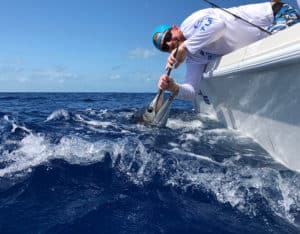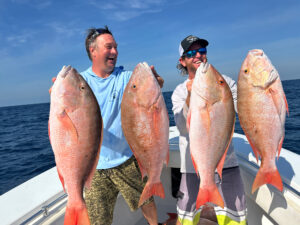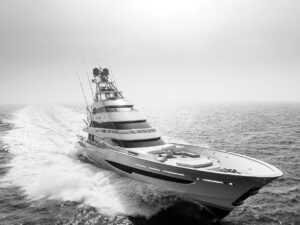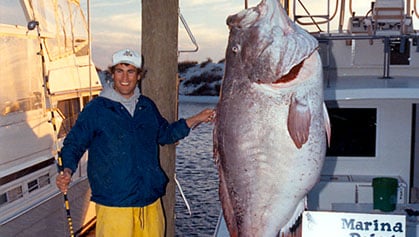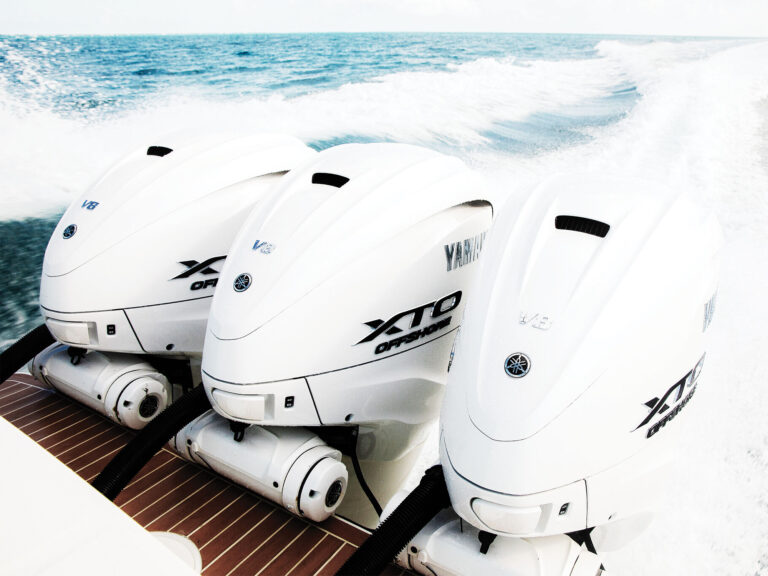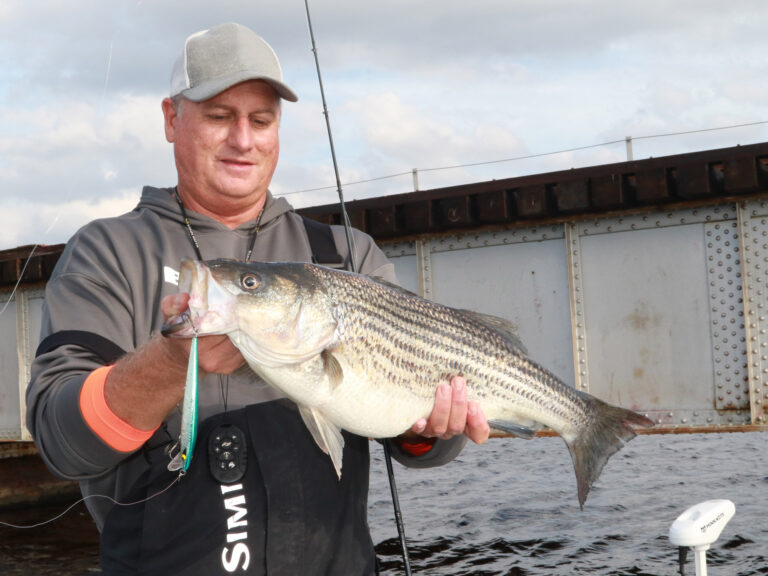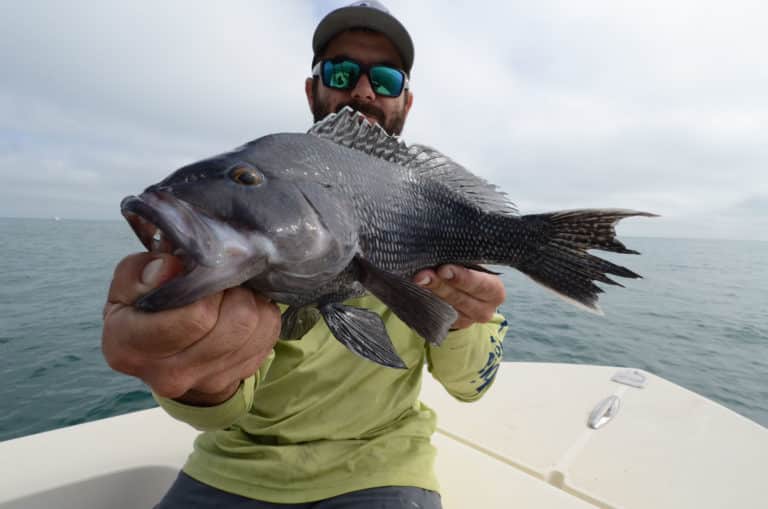
A lazy swell rolled in from the open Pacific, gradually forming into a single cresting wave as it encountered ever-shallower water. Our panga steadily chugged along at little more than a walking pace just behind the surf line, so close to the verdant jungle backdrop that I could see flocks of scarlet macaws browsing on sea almonds.
Beaches such as this offer prime real estate for predators to pick off smaller fish that dart about the turbulent water to feed on the countless shrimp, sand eels, shellfish and other tasty tidbits revealed by powerful wave action continually scouring the sandy seabed.
An open beach off Panama’s Coiba Island is not a great place for a lone blue runner to be swimming, especially one bridle-rigged to a circle hook. Certainly the fish so tethered at the end of my line was not having the best of days, and a sudden increase in activity telegraphed up the rod told me things were about to get much worse for that hapless baitfish.

I tensed in anticipation of an imminent strike. Moments later, I spotted the runner skipping across the surface, closely followed by the unmistakable seven-stranded dorsal fin of a roosterfish as it surged forward to engulf the fish in an explosion of whitewater.
For two or three seconds, I allowed line to pour unchecked from the reel, then gently eased the lever drag forward to the strike position. I waited for the line to tighten, and smiled as my rod bent in confirmation that the hook had indeed found its way into the sweet spot in the corner of the fish’s jaw.
“Cinquenta!” shouted my captain a bit later, when he leaned over the side and grabbed my fish just ahead of its tail. Hoisting it aboard, he announced that I had indeed caught the 50-pound roosterfish he knew I so desperately wanted to catch. I could see that he was being overly generous, the fish weighing at best 40 pounds or so. I knew it wasn’t the 50-pounder I have sought for so many years now.
Roosterfish, Nematistius pectoralis, inhabit the eastern Pacific, from the Baja Peninsula south to Peru. It’s the only species in the genus Nematistius and, with its iconic seven-stranded dorsal fin — like the rooster’s comb from which the species gets its name — the roosterfish is one of the most recognizable species of game fish. For a great many saltwater anglers, as for me, it’s a bucket-list species.
Over the years, I have caught lots of roosters during numerous trips throughout Costa Rica and Panama. Often I have fished destinations where fish over 50 pounds are caught with some degree of regularity, but a 50-plus-pound trophy always seems to elude me.
Are there ways I can fine-tune where, when and how I fish in order to maximize my chances of catching that elusive trophy rooster? Keen to put the odds as much in my favor as possible in my ongoing quest, recently I contacted several experts who regularly see big roosters caught in their waters.

Tricks from Tropic Star
Tucked into Piñas Bay in southern Panama, very close to the Colombia border, Tropic Star Lodge ranks as one of the world’s great fishing lodges. Numerous world-record roosters have been caught by anglers fishing these prolific waters, including the men’s 8-pound class, currently held by a 54-pound, 9-ounce rooster.
“There is always a degree of luck to catching any trophy fish, but there are certainly things that anglers can do to increase their chances, namely look for the optimal time of year depending on area, baits and techniques,” says Capt. Richard White, Tropic Star’s fishing director and assistant manager. “In our waters, the best months for larger roosterfish are from April, when the water starts to become very clear, till around August.
“Live bait is the best bet for larger roosterfish, especially hardtails [blue runners], mullet and bonito,” White continues. “Large roosterfish have such big mouths, a 50-pound rooster can easily engulf a large mullet or bonito. We swim live baits bridled with a circle hook. Smaller hooks are generally preferred, but you need a hook with a gape big enough to hook those larger fish.
“A lot of the bigger fish are hooked from a downrigger, with baits fished at about 30 to 50 feet down.” White emphasizes that big baits take big roosters: “You’ll have less action overall, but when you do get that bite, you know it’s going to be a big one.”

White says that both swimbaits and poppers work effectively for roosterfish. Color seems less important than matching the hatch in terms of size. Adjust your retrieve until you find the speed that the fish want, and note exactly where you get bit. “Was it on the sunny side of the rock or the shady side? Was it in the whitewater or the swirls?” White asks. “Was it just after a pause, or was it a reaction bite? If you can start to identify a pattern, you’ll be able to refine your technique to catch more fish.”

Roosters on the Tuna Coast
Panama’s remote “tuna coast” on the Azuero Peninsula is home to Panafishing Lodge, another destination where trophy roosters are very much a house specialty.
“Catching a 50-plus-pound rooster on the tuna coast is definitely a realistic target,” lodge owner Pierre-Andre Demauge says. “Big roosterfish can be elusive and picky, but some anglers will catch a trophy on their first day, while it might take others several trips before they catch a really big one.”
Demauge says that in their waters, “big roosters are much more likely to eat a live bait than a lure. We find that the big fish move around a lot, with no one spot consistently producing trophy fish. In our area, there is no such thing as ‘targeting a big rooster.’ We just fish a likely spot, have fun with whatever wants to bite, and sooner or later a big rooster will show.
“On the tuna coast, the biggest roosterfish tend to be caught in the wet season, especially in May, June and October,” Demauge continues. “I think this is due to the fact that bigger fish feed primarily on green jacks, which are abundant during the wet season. Juvenile roosters love to hunt the balls of anchovies so abundant in the dry season.”

For Demauge, live bait is much more effective for trophy roosters than any lure. The best bait in these waters is a 7- or 8-inch cojinua (green jack), but many other species will work. “We’ve seen big roosters eating anything from 2-inch anchovies or needlefish to small yellowfin tuna or jack crevalle.”
But Demauge says that many anglers like to fish lures, and “we catch our share of big ones on all kind of artificials.” Demauge cites one major upside to lure‑fishing: “Nothing beats the strike of a big rooster on a topwater lure!”
Lures that can be worked fast produce best, he says, citing a 6- or 7-inch popper or stickbait worked energetically with short strokes and nonstop action as the most reliable lure for roosters there. However, at times, roosters can be reluctant to strike lures on top. Then it’s time to send down the jigs.
Read Next: Breathtaking Roosterfish Leap
“For the past few years, slow-jigging has proved a really effective and unexpected way to target trophy roosters. Fighting a big rooster on slow-jigging tackle is something that even the most experienced angler will remember!
“When that big rooster does eventually show up behind your lure, its comb sticking aggressively from the surface, whatever you do, don’t stop working your lure!” Demauge cautions. “When you are hooked up, maintain steady pressure, and if the rooster races toward the boat, be ready to reel as fast as you can. Roosterfish are masters at unhooking themselves if you let them have any slack.”

Costa Rica in the Offseason
Repeating the refrain of big baits for big roosters, Allan Smith, fishing director at Crocodile Bay Resort on Costa Rica’s Osa Peninsula, says: “Big roosters want a meal, not a snack. Our bait of choice are live bonitos, trolled slowly.” It can take longer to get live baits the right size, and you won’t get as much action, but when you do get the bite, it will likely be the big fish you’re looking for.”
Smith says the odds of bigger fish also increase when fishing pressure has eased off.
“The best months here off the Osa Peninsula are the offseason, August through November, when fewer boats on the water mean some spots don’t get touched for weeks at a time. “The big fish tend to make more mistakes when there is little fishing pressure.”
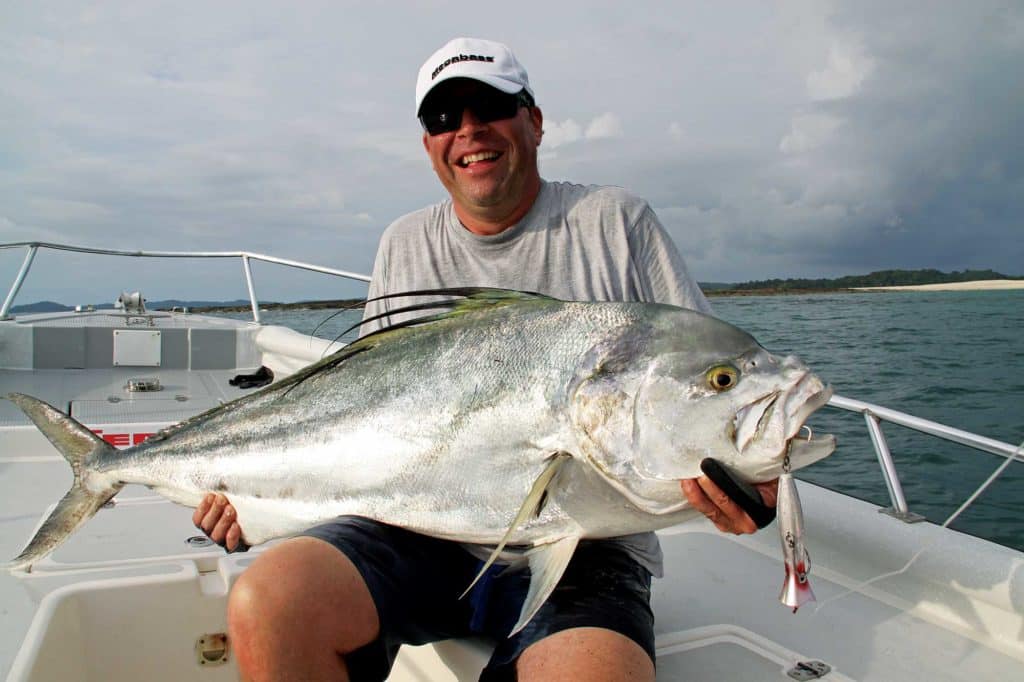
Mexican Monsters
More anglers have probably caught their first roosterfish in the waters of Mexico than any other country, especially around the Baja Peninsula. The current International Game Fish Association all-tackle world record is held by a 114-pound fish that was caught at La Paz in 1960. A quick scan through the list of various line-class records reveals no fewer than a dozen current line-class rooster records from Baja.
“We catch many roosterfish in June and July over 60 pounds,” says Grant Hartman, owner and head guide at Baja Anglers in Cabo. For their waters, Hartman says, live mullet or caballito (scads) produce the biggest fish, though big Pencil Poppers and similar lures also work.
“For the really big fish, you usually have to put in the time on the water, but having said that, I have had many anglers catch a giant roosterfish on their very first day.”

Global Perspective: Fish Those Lures!
“Catching a big rooster on a lure has nothing to do with luck, only hard work and patience,” says Julien Lajournade, editor of the French global fishing magazine, Voyages De Pěche.
Lajournade, who has caught his share of large roosters, notes: “More people fish with lures than bait at the lodges I have fished, and in recent years, a lot of very big fish have been caught with poppers, including trophy roosters exceeding 60 and even 80 pounds.
“In my opinion,” Lajournade continues, “the best lures are big poppers. XL-size poppers made for giant trevally can fool monster roosters, especially in deep rocky places.” Lajournade favors a white belly with a light-blue back, rigged with a single strong treble hook at the rear. He attaches it to a 60-pound fluorocarbon leader.
But, Lajournade says, rooster hunters should avoid heavy drag settings. “You’ll lose many roosterfish if you fight them giant trevally style.” When fishing relatively deep or in agitated water, Lajournade suggests big, deep-cupfaced poppers fished slowly with pauses. But when shallower and in calm waters, he says, “use a steady retrieve, popping regularly but without violent splashes. Remember,” he adds, “make long casts and stay focused; roosters don’t strike a lure twice. Never slow down a retrieve, whatever is happening behind the lure.”

Other Rooster Destinations
In addition to several countries already mentioned, Guatemala, Honduras, Nicaragua, El Salvador, Colombia, Ecuador and Peru all have roosterfish hunting in their inshore waters. Guatemala’s Pacific resorts widely seek roosters inshore as an alternative to the popular sailfishing offshore.
The main issue when planning to fish in little-known or underdeveloped countries is finding a reliable outfitter who can arrange safe boats with knowledgeable crews. Following the recent cease-fire and peace agreement with the FARC terrorists, Colombia is already starting to attract an increasing number of sport fishermen; it certainly will become the next big Central American destination to draw anglers from around the globe — where, among other game fish, you can be sure they’ll target roosters.
About the Author
The work of Dave Lewis, a retired firefighter and U.K.-based angling photojournalist, appears regularly in publications around the world. He travels extensively, and acts as host and guide to groups of sport fishermen traveling to salt- and freshwater destinations (visit davelewisfishing.com). His latest book, Destination Angler 2, was published in summer 2018.

